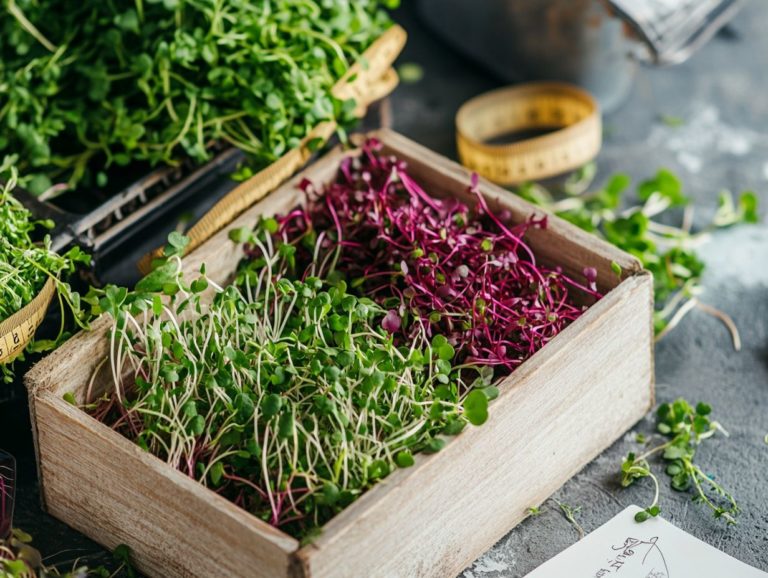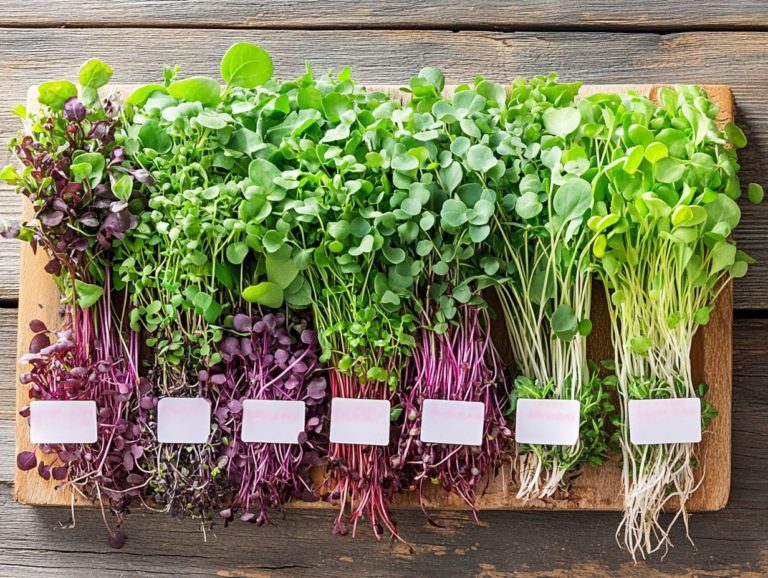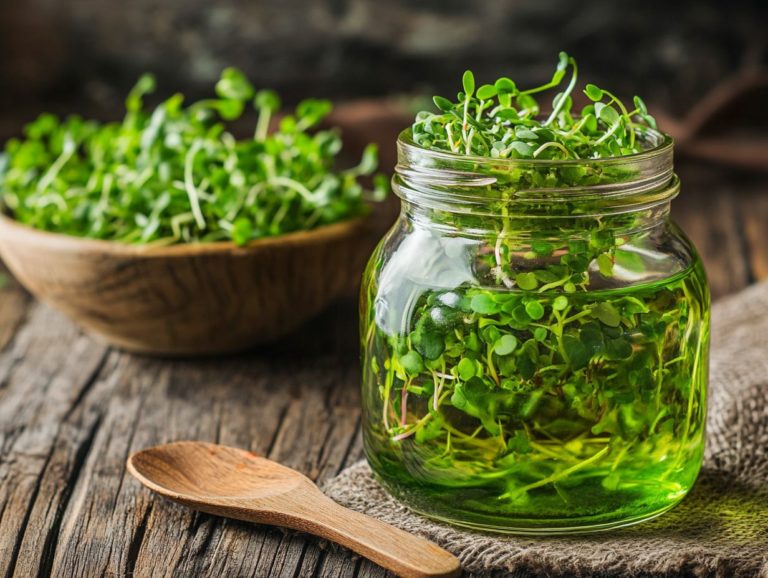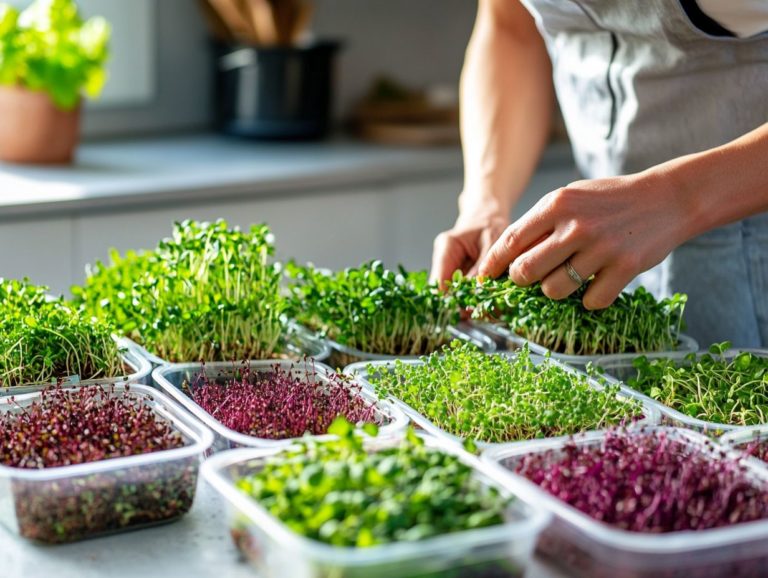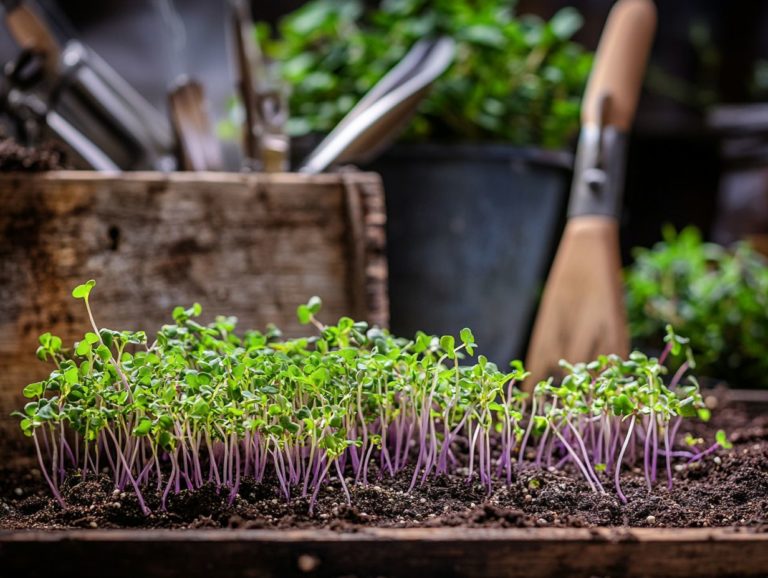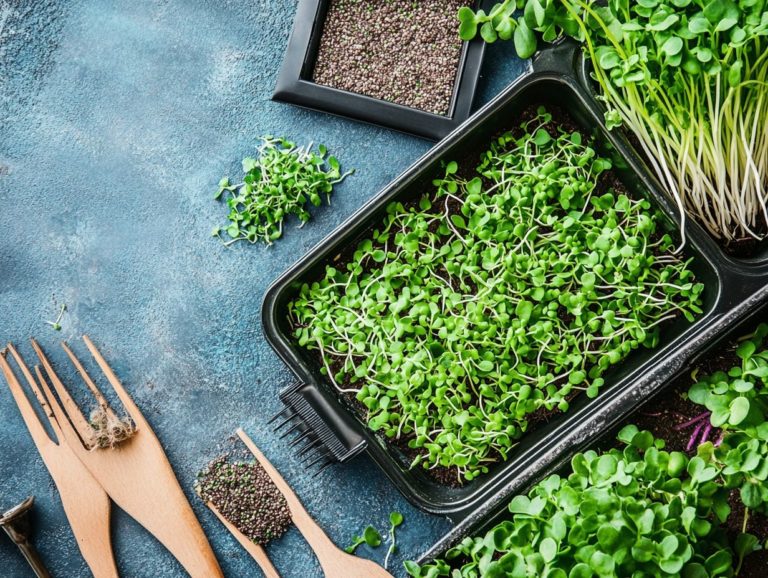What Are the Best Conditions for Microgreens?
Microgreens have taken the culinary world by storm, delivering vibrant flavors and remarkable nutritional benefits in a compact package. They have become a staple in many home gardens.
This article delves into what microgreens are, their myriad advantages, and the art of cultivating them successfully in your own home. You’ll learn about essential gardening tools, their specific light and temperature requirements, how to choose the best seeds, and tips to sidestep common pitfalls that could hinder your efforts.
Discover how easy it is to start your own microgreen garden today! You ll also uncover delectable ways to integrate these tiny greens into your meals, elevating both flavor and health, along with healthy eating tips.
Contents
Key Takeaways:
- Microgreens are nutrient-dense, convenient, and easy to grow at home.
- For optimal growth, microgreens need proper lighting, temperature, soil, and watering techniques, along with careful attention to the germination process.
- Choosing the right seeds and avoiding common mistakes are key to successful microgreen cultivation.
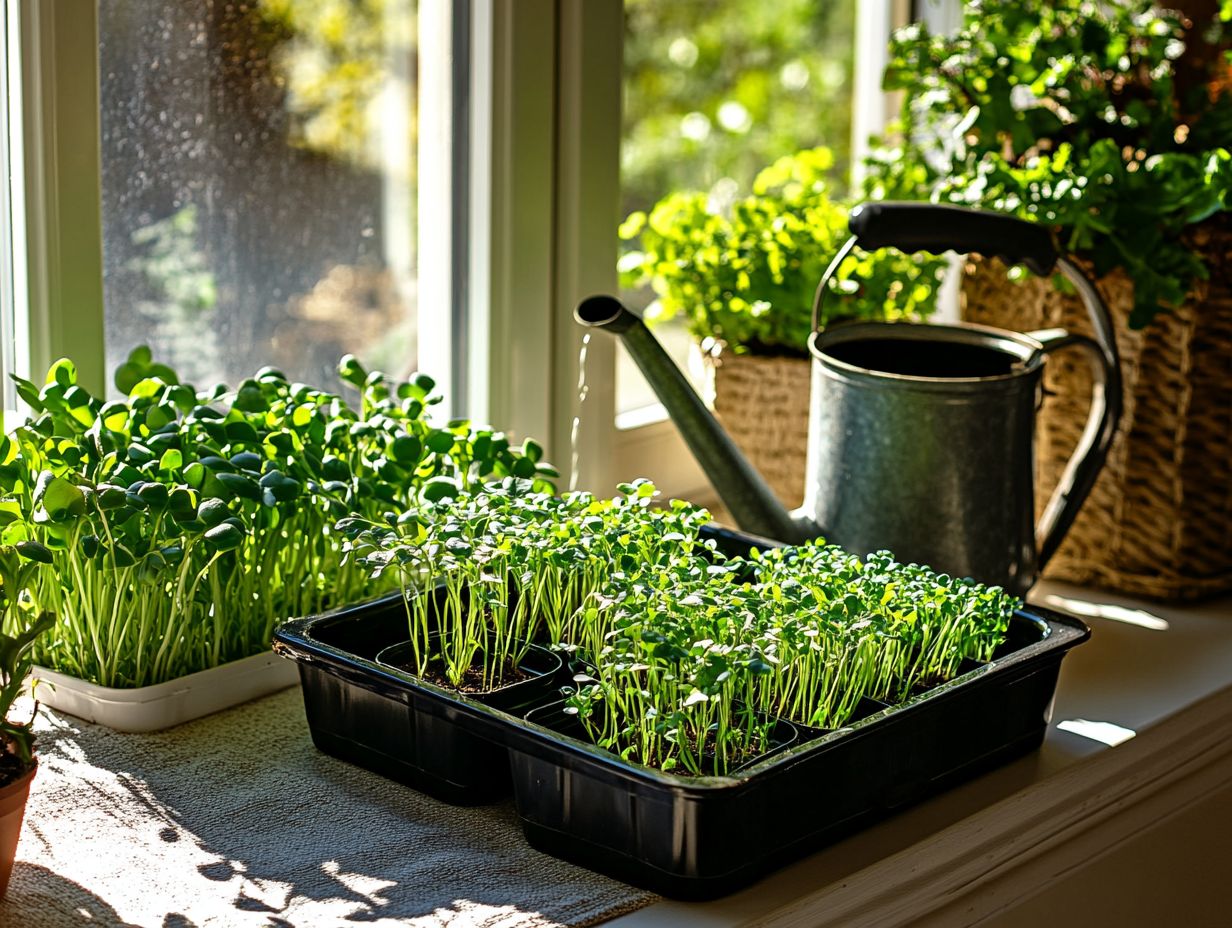
What are Microgreens?
Microgreens are young, edible plants that you can harvest just after the first true leaves have developed. This typically occurs within 7 to 21 days after germination. They re brimming with nutrients and flavor, often used in culinary dishes to elevate both the aesthetic and nutritional value of your meals.
Popular microgreens, like arugula, basil, and broccoli, are celebrated for their concentrated vitamins and antioxidants. They are a standout choice for anyone looking to enhance their vegetable intake.
But don t overlook the lesser-known varieties like radish, beet, and pea shoots; they bring unique flavors and textures that can transform salads, sandwiches, and soups into something spectacular.
The growing process is refreshingly simple. Microgreens can flourish in small spaces using either soil or hydroponics, a method of growing plants without soil, using water and nutrients instead. To ensure optimal growth, it’s important to know what is the best temperature for microgreens. This makes them accessible even for urban gardeners.
With every bite, you enjoy a burst of flavor while reaping health benefits, such as enhanced immune support and improved digestion. This is thanks to the high levels of vitamins K, C, and E. By incorporating these nutrient-dense greens into your daily meals, you can significantly boost your overall nutrition, leading to a more vibrant lifestyle.
Benefits of Growing Microgreens
Growing microgreens brings a multitude of advantages, enhancing your healthy lifestyle while serving as a concentrated source of essential vitamins and minerals. They are a remarkable addition to any home garden or kitchen gardening endeavor, promoting sustainable practices.
These petite greens are not only straightforward to cultivate but demand minimal space. This makes them ideal for balcony gardening or even an indoor setup on your kitchen windowsill.
Their rapid growth makes them easy to cultivate, aligning perfectly with sustainable gardening practices and allowing you to embrace freshness and well-being effortlessly.
Nutritional Value and Convenience
Microgreens offer exceptional nutritional value, often boasting higher levels of vitamins and antioxidants compared to their mature counterparts. For anyone seeking to enhance their dietary habits and incorporate more fresh vegetables into meals, these tiny greens are truly invaluable.
Their ease of preparation and versatility in the kitchen further elevate their appeal, allowing for seamless integration into salads, sandwiches, and smoothies.
Packed with essential nutrients such as vitamins A, C, E, and K, these petite greens not only enhance the visual appeal of a dish but also deliver impressive health benefits.
For instance, arugula microgreens provide a substantial boost of vitamin K, vital for bone health. Meanwhile, broccoli microgreens are rich in sulforaphane, an antioxidant celebrated for its cancer-fighting properties.
By incorporating a variety of microgreens into daily diets, you not only add vibrant flavors and intriguing textures but also embrace a nutrient-dense approach to healthy eating. This encourages culinary exploration and opens up a world of diverse possibilities in your kitchen.
Begin your journey today! Start growing your own microgreens and explore exciting recipes to enhance your meals.
Optimal Conditions for Growing Microgreens
To achieve exceptional results in growing microgreens, grasping the optimal conditions is essential. Microgreens flourish in well-drained growing mediums and demand adequate sunlight exposure for robust growth.
Effectively managing water is vital to ensure efficient germination while preventing seedling disease, which can disrupt the germination process. Maintaining a controlled indoor farming environment is key for consistent growth rates and nutrient levels.
Light and Temperature Requirements
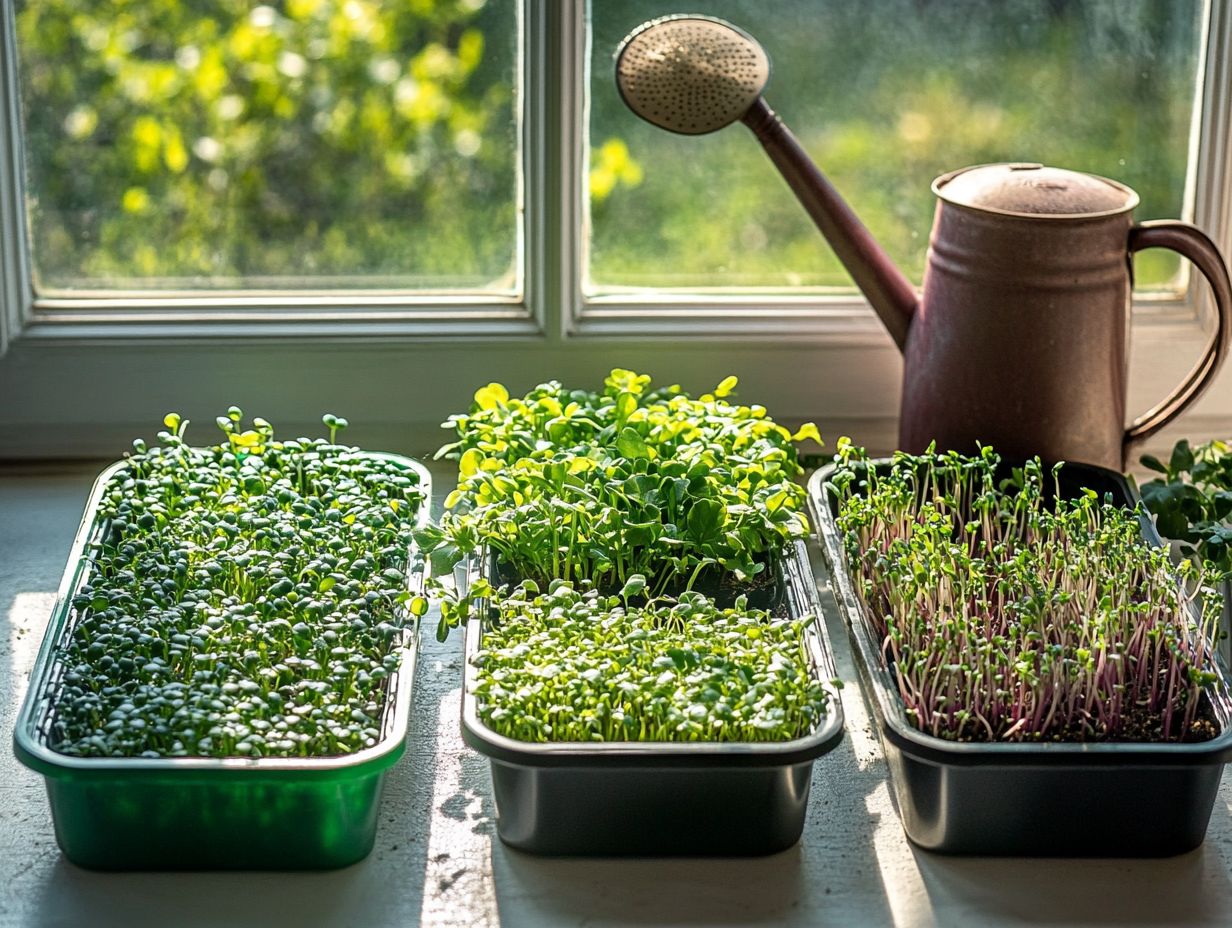
Microgreens thrive under specific light and temperature conditions. Most varieties prefer bright sunlight or fluorescent lights to achieve optimal growth.
Ideally, you should maintain temperatures between 65 F to 75 F (18 C to 24 C) to encourage strong plant growth and proper germination. These conditions significantly impact the speed of growth and the nutritional value of your microgreens.
For example, insufficient light can result in legginess, while excessively high temperatures can stifle seedling growth.
By employing indoor gardening techniques, such as using grow lights, you can effectively replicate natural sunlight. This also helps sustain those ideal temperature ranges, creating a consistent environment for your crops.
With careful adjustments to light duration and intensity, along with diligent temperature control, you can ensure that your microgreens grow robustly. Additionally, using the right soil is crucial; for more information, check out what soil is best for microgreens. This enhances their flavor and nutrient profiles, ultimately leading to vibrant and health-packed greens.
Soil and Watering Techniques
The choice of growing medium is crucial for successful microgreens cultivation. Many growers prefer options like soil, coco coir (a natural fiber made from coconut husks), or specialized seed-starting mixes.
Each selection has its advantages. For example, coco coir is eco-friendly and excels at moisture retention, while seed-starting mixes typically offer superior drainage and nutrient content.
To achieve optimal growth, it s essential to adopt effective watering techniques. A gentle misting method can keep the surface moist without drowning the soil, thereby minimizing the risk of mold.
Soaking your seeds for a few hours before planting can significantly enhance germination rates. Keeping an eye on moisture levels by feeling the substrate will help you maintain the perfect balance, leading to lush and vibrant microgreens.
Choosing the Right Seeds for Microgreens
Choosing the right seeds is crucial for your microgreen cultivation journey. Each type of microgreen seed brings its unique flavors, textures, and nutritional benefits.
You’ll find a variety of options available, with popular choices like broccoli, radish, and basil standing out. Opting for organic seeds can enhance both the health benefits and the overall quality of your microgreens, ensuring a vibrant and nutritious harvest!
Types of Seeds Suitable for Microgreens
You can cultivate a variety of microgreens, each offering distinct flavors and culinary applications. Take arugula, for instance, with its delightful peppery kick, or sunflower microgreens, which bring a satisfying nutty flavor. These tiny seeds are nutritional powerhouses, enhancing the overall quality of your dishes.
Consider radish microgreens for a spicy zing that complements salads beautifully. Basil microgreens infuse a sweet, aromatic essence into your pasta and sandwiches. Pea shoot microgreens add a fresh, sweet crunch, making them an ideal addition to stir-fries or as a vibrant garnish. For those new to gardening, exploring the best microgreen varieties for beginners can be incredibly helpful.
In terms of nutrition, microgreens pack a remarkable punch, often boasting higher concentrations of vitamins A, C, and K than their mature counterparts. They not only elevate the visual appeal of your plate but also enhance its health benefits.
Start growing your microgreens today for a fresh and healthy addition to your meals!
Common Mistakes in Growing Microgreens
As you start growing microgreens, be aware of common mistakes that can hinder your success. Issues like poor light exposure and inadequate water can affect germination rates and stunt plant growth.
These problems can compromise the quality of your microgreens. Approach each step with care and attention.
How to Avoid and Correct Mistakes

To avoid common pitfalls, keep a close eye on your watering schedule and light management. Proper care leads to healthier plants and higher yields.
Understanding the specific water needs of different microgreen types can boost their vitality. A moisture meter helps you find the right balance, preventing overwatering and underwatering.
Light exposure is crucial; aim for 12 to 16 hours of light daily, especially from full-spectrum LED grow lights.
Creating a consistent environment by regulating air circulation and temperature enhances growth. This promotes vigorous plants and nutrient-rich harvests.
Embrace these strategies, and growing microgreens will become an enjoyable and rewarding task.
Harvesting and Using Microgreens
Harvesting microgreens at the right moment maximizes flavor and nutrition. They are usually ready when they reach 2-3 inches in height, just before true leaves form.
These nutrient-packed greens are versatile in the kitchen, elevating salads, sandwiches, and garnishes.
When and How to Harvest Microgreens
Harvest microgreens when they reach 2-3 inches, typically within 7-21 days after seeding. Cut just above the soil level to keep the remaining plants healthy for possible re-harvest.
Timing is key for optimal flavor and freshness. Use sharp scissors or a knife for a clean cut, and have clean containers ready for your harvest.
For best results, harvest in the morning when moisture levels are high to enhance crispness.
After cutting, rinse the microgreens gently to remove any soil. Consume or store them quickly to preserve their taste and nutrition. To avoid any pitfalls, check out common mistakes in growing microgreens. Elevate your harvest experience and enjoy the benefits in your meals!
Ways to Incorporate Microgreens into Meals
Incorporating microgreens into your meals can truly elevate both the presentation and nutritional quality of your dishes. These tiny greens are perfect for adding to salads, sandwiches, smoothies, or even as garnishes for a variety of recipes, delivering a delightful burst of flavor and essential nutrients.
Imagine tossing a handful of radish microgreens into a vibrant fruit salad not only does it boost the dish’s visual appeal, but it also introduces a peppery kick that beautifully complements the sweetness of fruits like watermelon and berries. Alternatively, blending pea shoots into your morning smoothie infuses it with a refreshing green essence while enhancing its vitamin content.
With their remarkable culinary versatility, microgreens can effortlessly elevate your pasta dishes. A sprinkle of basil microgreens can transform a simple plate into a gourmet experience. Embracing microgreens in your daily meals is an easy yet impactful step toward healthier eating, inviting you to explore your creativity in the kitchen.
Frequently Asked Questions
What Are the Best Conditions for Microgreens?
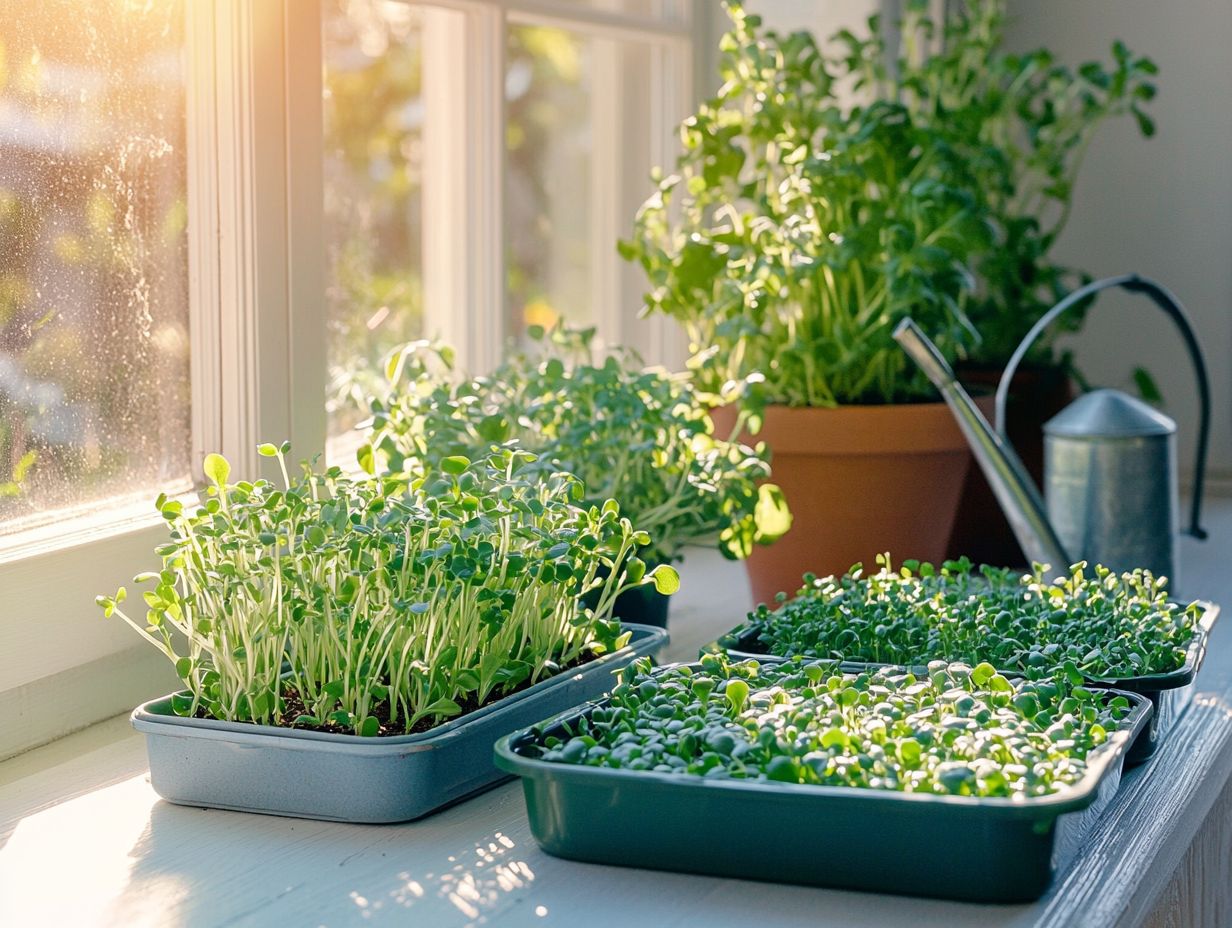
The best conditions for microgreens include a warm and humid environment, proper air circulation, adequate lighting, and well-draining soil.
What is the ideal temperature for growing microgreens?
Microgreens thrive in temperatures between 60-75 F (15-24 C), with the ideal temperature being around 70 F (21 C).
How much light do microgreens need?
Microgreens require at least 6-8 hours of light per day, preferably from a south-facing window or grow light.
Do microgreens need fertilizer?
Yes, microgreens benefit from a diluted liquid fertilizer once or twice during their growth cycle. It is important to use a fertilizer specifically designed for microgreens.
How often should microgreens be watered?
Microgreens should be watered once a day, preferably in the morning. The soil should be kept moist, but not waterlogged.
What type of soil is best for microgreens?
A lightweight and well-draining soil, such as potting mix or seed starting mix, is best for microgreens. Avoid using heavy soils or soils with added fertilizers.

